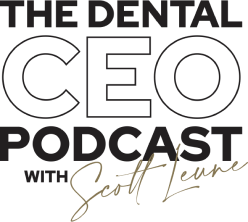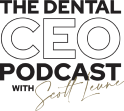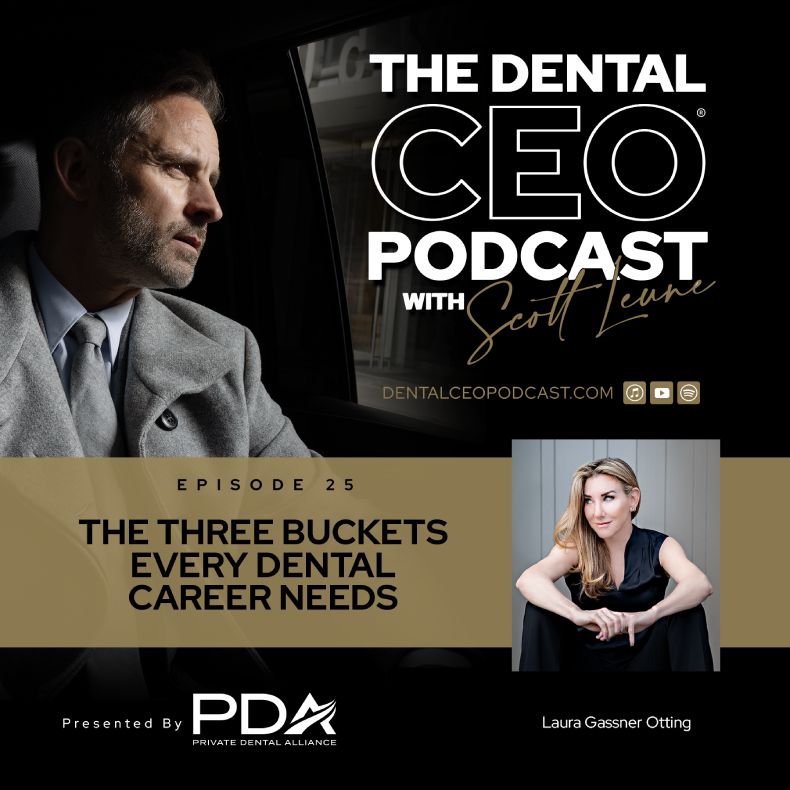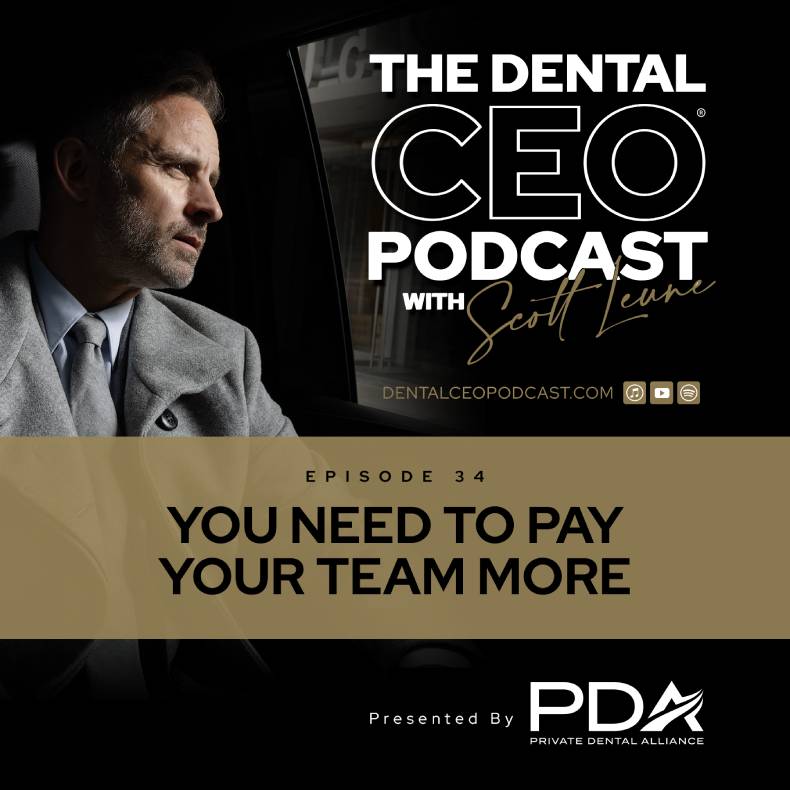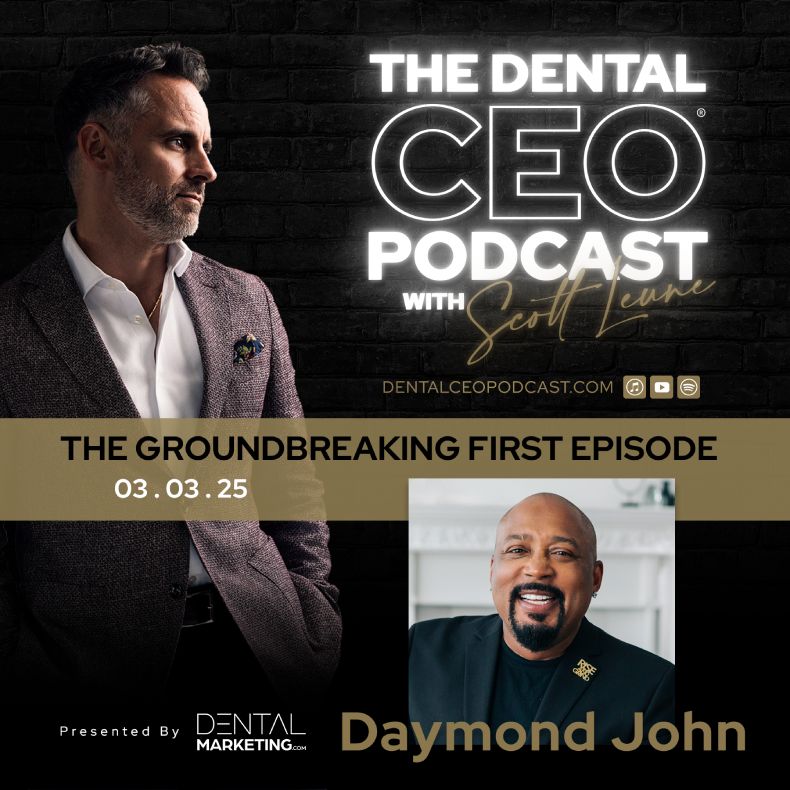Dental CEO Podcast #27 – Structuring Dental Associate Agreements That Protect Your Practice
Hiring the right associate can make or break your dental practice. In this episode of The Dental CEO Podcast, Dr. Scott Leune breaks down the 10 most important elements of a strong dental associate agreement. From tiered compensation and lab fee adjustments to notice clauses, CE commitments, and profit-sharing opportunities, Scott explains how to create agreements that are fair, balanced, and built for long-term success.
Whether you’re bringing on your first associate or refining an existing contract, this conversation gives you a clear framework to protect your practice, support growth, and attract top-performing dentists.
Highlights
- Associate Dentist Compensation: How to structure compensation for associate dentists, including tiered compensation based on production levels, and the importance of aligning associate pay with practice profitability.
- Contractual Considerations: Key elements that should be included in contracts with associate dentists, such as notice periods, continuing education commitments, and agreements on lab and supply usage.
- Performance Metrics: The importance of tracking associate performance through diagnostic rates and case acceptance rates
- Profit Sharing and Incentives: The episode touches on profit-sharing models and how they can be incorporated into associate agreements to align interests and incentivize high performance.
- Practice Management Strategies: Strategies for managing practice operations, such as column load management and mandatory referral agreements, to ensure financial viability and ethical patient care.
Speakers

Dr. Scott Leune
Scott Leune, known as The Dental CEO, is one of the most respected voices in dental practice management. From his seminar room alone, he has helped launch over 2,000 dental startups and supported more than 20,000 dentists across practices worldwide. Named one of the 30 Most Influential People in Dentistry, Leune delivers practical, no-fluff strategies that empower dentists to lead with confidence, scale efficiently, and achieve real personal and financial success.
Watch Episode
Read Full Transcript
Scott Leune: So something that's bothered me my entire career is that the largest supply companies give huge discounts to the large DSOs while private dentists have to just pay more and more and more for things every single year. What's also bothered me is that there are some buying groups out there in dentistry that claim to save private dentists a bunch of money, but those buying groups are still utilizing the big companies that have been overcharging dentists the entire time, and those buying groups aren't necessarily giving dentists the low pricing that the DSOs still get comes a solution, a new sponsor of ours, I'm super excited to announce that the Private Dental Alliance is trying to solve this problem. Finally, someone's doing it where private dentists only join their alliance and they get super low pricing on equipment supplies and lab fees competing with the DSOs, putting them on a level playing field with the DSOs.
If you want to understand how much money you would save, text the word savings to 4 8, 6 5, 9 savings to 4 8, 6, 5, 9. Do that right now and you will be able to see very quickly a price comparison of what you're currently spending with whoever you're spending it with to what life would look like if you were in the alliance. Be a private dentist that takes advantage of this. Save a ton of money. Don't keep going month after month, losing money because you just haven't gone through the process of joining the alliance. That's Private Dental Alliance. Super excited. Finally, we can save some real money as private dentists. So as a practice owner, have you ever had an associate where the situation was causing you to lose money, you got burned financially or you got burned by them leaving and you couldn't replace 'em? Or there's some lab issues. There's CE questions like how should we pay an associate dentist so that they are incentivized to do very well, but we as a company are also protected where we need to be protected? What about lab? What about ce? What about profits, interest or referrals or how many columns should they get? What are they going to produce? What percentage do we pay? All of those things we are going to go over and unpack here on this next episode of the Dental CEO podcast.
Well, there's a lot we got to unpack here, so I hope that this conversation, this podcast episode starts getting your wheels turning and thinking about either updating your contracts with associates or what about that next associate you're going to bring in, and you might find as I go through this, you might find where you may have gone wrong in the past, some pain points you've had, bad memories, bad experiences might've been solved, had you followed some of this stuff. So let's start out with kind of the big question. How much should an associate get paid Before we get answered that question, you need to understand that the company doesn't get profit at a set percentage. The less an associate produces our profit might go to zero, or if they produce a ton, our profit might be unreasonably high, right? So our profit isn't fixed. It's not like a typical practice might pay an associate, I'm just going to make something up 30% of their adjusted production.
Well, your profit isn't always a fixed percentage and so therefore maybe we shouldn't make their pay a fixed percentage. Maybe if they are in the lower producing amounts, we should pay them a smaller percentage because our profit margin might've gone away and if they produce a normal amount, we should maybe pay them a normal percentage because our profit might be a normal percentage and if they produce a whole lot, how about we pay them a whole lot, a much bigger percentage? This is a tiered version or a stepwise version of paying them. So you're going to have to put your own numbers here, but we need a teaching example. So in this teaching example, let's just say a typical dentist in your area will do 50,000 a month in production and a typical dentist in your area gets paid. I'm just going to make something up 32%, okay?
Obviously your numbers can look way different than that, but let's just assume that that is typical for teaching purposes, okay? I don't want to pay an associate 32% of their adjusted production hoping that they're going to produce 50,000. What if they produce 40,000 or 35,000? Shit, we made nothing. We maybe have lost money if I pay them 32%. So what I want to do is I actually want to take that kind of production. That 50,000 a month might be typical, but what I want to say is, okay, for the first zero to 35,000, that's going to be kind of level one and then I've got maybe 35,000 to, I'm just going to call it 60,000 would be like level two, and anything more than 60,000 a month would be level three. So for that first level, for the first $35,000 they produce, I'm going to pay them a percentage less than typical.
If typical is 32%, maybe I pay them something like 28% or maybe even less than that, but 28% on the first 35,000 they produce now level two for all the dollars after that. So from 35,000 up to 60,000 production, I'm going to pay them something higher than typical because I paid them lower than typical before for the first dollars. Now for the second dollars, I'm going to pay 'em higher. So maybe I pay them 34% of level two, and my God, if they're a high producer, then all the dollars after 60,000, I might pay them a really high percentage. I'm just going to make it up maybe 40%.
So if we do the math here, I'm just going to pull out my calculator. You would need to do this math and adjust these percentages as well. I literally just pulled these percentages out of my rear. So who knows if these actual percentages are going to make sense, but I'm going to do the math. Let's say I've got a dentist producing 70,000 in a month. Typical is 50,000. This guy is doing 70,000. If I were to pay him a typical wage, I'd pay him 32% of anything he does. So 32% of 70,000. So his typical pay would be 22,400. That's typical. I'm writing that down 22,000. Well, if I pay him instead in this kind of tiered level, he's going to get 28% of the first 35,000, so that's $9,800. He's then going to get 34% of the next 25,000, so that's 8,500 and then he is going to get 40% of the last bit, which is 10,000, so that's 4,000.
So if I add this up, I've got 4,000 plus 8,500 from tier two plus 9,800 from tier one, I end up with $22,300. Basically the exact same amount had I paid 'em 32%. Now that's not good. I actually want him to make more. If he's a high producer, I want him to make more, so I might go back and adjust this. I might now change my percentages like, okay, let's leave the bottom percent at 28. Let's make the middle percent 35 and it's like the top percent 42. Okay, so I'm going to do the math again and I apologize. I know that this might be annoying to listen to me do math, but this is a really important concept. So let me do the math again. So for the first 35,000, he made 28%, that's $9,800. The next 25,000, I raised that to 35% commission.
So now he's at 87 50 and the last 10,000 he made 42% on. So now he's at 4,200, so 4,200 plus 87 50 from tier two plus 9,800 from tier one. Now he's making a little more. He is making almost 23,000. So I'm going to do that kind of exercise until I'm happy with how much he makes if he's a high producer. So now a high producer is going to earn more in my practice than if they just got paid a flat rate, right? They're going to earn more in my practice. That's what I want, but a low producer is going to earn less in my practice than I paid 'em a flat rate. That's what I want as well because I can't afford to pay a low producer as much because we have no profit left. See, if I had a low producer and they were only doing in this particular example, let's just say they're doing 40,000 a month, then they would get paid about $10,000 or so, and that is less than the 12,800 I'd pay him if I paid him a flat rate.
So to sum this up and put a bow around this, I want to come up with tier one, two and three percentages where tier one is lower than the going rate. Tier two and three are higher than the going rate, and tier three is so high that if I've got a tier three dentist, they're making more with me than someone else would pay 'em, and I can afford it because they are giving me a lot more profit and if I've got a tier one dentist, heaven forbid, a low producing dentist, I'm protected some. I'm not giving them a normal rate because they're not a normal producer, they're a tier one producer, so they should get a tier one percentage. This becomes marketable when we're interviewing dentists because the dentist can see, oh my god, I can make up to 45% or whatever it might be.
I can make 50% maybe if I'm a higher producer. So this looks more attractive to them. It also gives them this drive or incentive to kind of jump to the next tier. I don't know why I'm not an expert in psychology, but there's something psychologically that happens when you can see a journey and a progression of you making more and more and more that's more powerful than just a flat percentage of you making more. And so tiered pricing to me is the way to go for a whole lot of practices that have associates. Now, let's take into account though, what about lab fees? Because a lot of practices, they've got a flat rate, 32% for pay, and they also have a flat rate where the dentist pays part of their lab fees. So they may say, okay, and the dentist pays 30% lab fees. Another way of doing that math is instead of calculating 32% lab fees and 32% of production, you could just adjust off the entire lab bill from the entire production and then do 32%.
It's the exact same math. That's what I actually want to do in this kind of tiered setup is if we want to have the associate pay for some of the labs, I'm just going to make the lab bill an adjustment off of their adjusted production before I then calculate their pay. It's a very fair way of doing it for them and of course for the company. So I'm going to set up these tiers. Tier one, two and three and tier two and three need to be high percentages. Tier three needs to be really high percentage and I am going to adjust off their adjusted production the entire lab bill before I then apply the percentage, and the result of that is the dentist pays for a minority of their lab bill and the practice pays for the vast majority of it. That's the result of this, and that's what we intend.
That incentivizes the dentist to not go on some spending spree with the lab work. We want to have them incentivized if we can on the lab cost. Okay, so we talked about adjusting off the lab bill before we calculate it and we talked about calculating based off of a tier. Those two things right now would've probably solved some significant problems you have had in the past with associates. Those two things right there. Now, let's add another issue, something that can kill the owner and that is the guarantee, the guaranteed minimum. I want to give you some thoughts on the guarantee. First of all, the guarantee only hurts the owner and helps the associate dentist so realize that it's the owner carrying the risk. If that's the case, then as the practice owner, I really want the smallest or the most temporary or no guarantee possible.
What is unreasonable is to always have a guarantee forever that is high, that puts all the risk on the owner and costs the owner money. And I'm sure you could imagine dentists that are perfectly happy sometimes with just doing very little work and just living off the guarantee while the company is getting killed, crushed losing money. So we need a balance here. We need something that is appropriate so we can recruit dentists and is fair for them, but we also need something that doesn't take advantage of the company. That is going to be a guarantee that is going to be a short-term guarantee for a modest amount of money. We still need a guarantee because just because a dentist started in your practice doesn't mean that they've done all the exams yet and all the exams results industry that fill their schedule and that they're going to be busy on day one, although if they are busy, the guarantee won't matter because the guarantee is like if they don't produce at least this much, then we're going to pay 'em this guarantee.
So if they're busy on day one, they won't even need the guarantee, but we need to have a guarantee there because it's reasonable need to support them financially as they build up their schedule in the beginning, and that guarantee needs to be short term one, two months max. I would hope if you're going beyond two months, they should have been able to build up their schedule. If you really did need that dentist, they should have been able to build up their schedule after two months. So I would try to have that guarantee two months or less if you can. Also, the guarantee needs to be a modest amount of money because we don't want to get in a situation where we're losing a fortune as a practice when they're onboarding because they're getting this fat guarantee and they're not even incentivized to try to fill their schedule because they're happy with this fat guarantee that is too damaging to the company.
It can't be a tiny guarantee either, but it needs to be something that's modest. Now, let me add another thing with this guarantee. We need to calculate the guarantee over the entire pay period, not per day. So it's not like they got paid a guarantee on Monday and then they had a monster Tuesday and so they got a big fat commission, but then Wednesday they got a guarantee. No, no, no, no, no, no, no. That puts all the risk on the practice. Again, what we want to do is we want to say, look, we might give you this daily guarantee, but we calculate it over the pay period. So you had 10 working days in the pay period. I'm just going to make something up. If your guarantee was whatever, $800 a day, I'm literally making it up and you work 10 days, okay? Then $8,000 is your guaranteed amount for that pay period.
We're going to now look at your production of that entire pay period and do the tiered formula, and if the production's higher than that for the entire pay period, you're going to get paid the production. If it's lower, you're going to get paid a guarantee. I don't mean for you to use 800, that's a pretty big number, but what I mean to say is you are going to do the calculation over all the days in the pay period to determine did they make the commission with a guarantee. You are not going to calculate it on every single day and pay either a commission or a guarantee for that one day. Alright? So that's guarantee. Now let's add some more stuff in here. What about notice? You see the associate is in this wonderful powerful position of saying, if I don't like this job, I'm going to go find another job and I don't have to tell my current employer and I'm going to wait and line it up so that when I'm ready I can just quit one and start the other and I wasn't damaged.
What a wonderful position for the associate to be in. That's possible. The problem is it can kill the company financially because we got patients that need care. They need care. We've got an ethical and a financial obligation to do that care. So we need to have a notice given by the associate that notice needs to be at least 45 days. It's so hard to find another dentist to pick up the care that needs to be continued. I'd say at least a month and a half of notice from the associate, and I know plenty of DSOs for example, that required 90 days notice, three months, but notice isn't enough because you have to also put a penalty on it in case the associate doesn't respect the agreement, respect the contract, you need to put a penalty. So let's say we say the associate needs to get 45 days notice if they're going to quit and for every day less than that, they give us if they left after 30 days instead of 45, they didn't give us the 45 days, they're going to owe us back money per day.
That's the key thing in there. We have to have some sort of price to pay if you don't follow the agreement, a price that's not just suing you or something, it's got to be a monetary price so that we're all in alignment, we're all going to do the right thing, we're all going to stick to what we agreed to. So we need a notice clause in there. Now again, it needs to be reasonable. So this isn't a podcast about let's do bad things for the associate and good things for the owner. No, no, no, no. I'm trying to say we need to be reasonable, but too many associate situations really damage the owner and people aren't talking about it. Everyone likes to go online and talk about how the owner damaged the associate, right? That's bad too. But this is a podcast episode about all those owners that have been hurt.
How can we structure an ethical agreement that's balanced and appropriate that will protect the owner like we should? So we got to have a notice clause. Now another thing that can screw an owner is you go and pay for all this training, this continuing education stuff. The associate says, Hey, can you pay for me to go learn how to place implants? And so you spend all his money, what are 10 grand or whatever you spend and then the associate puts in notice the month later. That is very damaging to the owner. So we need some sort of continuing education clause in the agreement and what I would recommend is that the associate owes you back the CE money on a prorated basis if they leave within a year. So in other words, if you spent 12 grand on CE and the associate didn't stay a year after that, they left after two months and they're going to owe you back 10 months worth prorated amount or in other words 10 of the 12 grand they'd owe you back and you could try with your HR company and your attorney to see if that's something that you could claw back out of their, if you could have an agreement that says you're allowed to call that back out of their paychecks, but you want to have it to where they at least owe that to you to compensate you to reimburse you fairly for the money you invested and they decided to not stay.
Alright? So you need some sort of CE commitment in that contract. Now let's keep going. Let's keep going. The next thing I want you to think about is the associate needs to agree to use the supplies you buy and to use the labs that you've got relationships with that you want for your company. You own the practice, you want your practice using certain labs and certain supplies and the associate needs to do that. They need to agree to it, but see, we need it in the contract. We need a supply and lab agreement that the associate is agreeing to use those supplies and that lab work that you have designated for your practice as being what you want to use. The reason why you need this in writing is because in many, many states there's kind of this gray area of control between the control of clinical care and the licensee can an associate demand to use a specific lab or specific supply in the name of patient care that goes completely against what the company owner dentist thinks is reasonable and appropriate.
And in some states that's an area of contention. So what we want to do is before we hire the associate, we want them to go ahead and review our supplies and the labs we use and if they want to work here, they need to be someone that is going to agree that that's okay. It's okay to use these supplies and this lab work and of course as an organization you have to have a way for them to request changes to that. But you don't want to get in a situation where suddenly the associate is telling you that you've got to spend $450 a unit for an all porcelain crown on number 31 in the name of patient care, right? You don't want a bad actor to take advantage of this legal issue. So you want to have in your contract that the associate agree that we are going to use and that associate is going to use the lab and the supply that you designate.
Okay? Next thing the associate needs to also agree in writing about referrals because in many private practice situations, the business model is relying on the associate referring dentistry to in-house or out-of-house specialists or of course the owner, general dentist that do that work. A great example is an owner owns a practice and has this vision that someday they will do all the implants and all the ortho in their practice and they decide, I'm going to add associates over the years and I'm going to give all those associates all my general dentistry, but in return I expect them to refer me the ortho and the implants and I don't want them doing the ortho because they may leave. I want to take care of the patient and I don't want them doing the implants because financially that's why I'm doing this. I want to do the implants.
I own the company. That's why I have associates, right? That's a very reasonable business model. Well, we got to make sure that in the agreement it says that mandatorily every patient is examined for the need of ortho and implants and if it's determined they would be a candidate that a mandatory consultation scheduled with the dentist of choice by the practice, which would be the owner in this example. That needs to be an agreement. It needs to be an expectation that associate you're going to get all these patients and all this dentistry in our organization get paid this way, but you have this requirement in this particular job in our organization that you look for this specialty work and if a patient might be a candidate, you refer that patient to the owner that needs to be in agreement. Alright, let's continue. So we need to also have in the agreement what I call column load.
How many columns is this associate going to get? Ideally, an associate dentist is working out of two columns with two great dental assistants and lots of hygiene exams to fill their schedule. They're getting great case acceptance, they're diagnosing the dentistry, they should be diagnosing, and at the end of the day, they're full, they're happy. Everyone's doing well, patient's taken care of. That's ideal. But sometimes we end up with an associate that's not ideal. We end up with an associate that doesn't diagnose much dentistry, they don't have great case acceptance, they've got poor communication skills. Maybe they're really slow and they take forever to do dentistry and what's the result of of an associate that doesn't diagnose a lot, that has poor case acceptance and is really slow. The result of that is that we're giving them two columns and they're only doing one column worth of production and that can kill the practice financially.
That is not fair to the practice. So we need to make sure that we set the column load or how many columns they get appropriately. So we would have in the contract an agreement or an expectation that says if you're a normal dentist, you're going to get a normal amount of columns, but if you produce less than this much per day, then we have the choice to limit you to one column. So what is that? If you've got an associate that is producing two thirds or less of what's normal, then you need to reduce them to one column and go hire another low producing associate. Put them in the other column. So let's put some numbers to this. If normal in your practice group or your area is like a dentist does six grand a day, but you've got a dentist that's doing 3,500, shit, you could lose a ton of money.
So you're better off putting that dentist in one column. Maybe they'll do 3000 in one column and finding another low producing dentist to do another 3000 in the other column. And you as a practice now are getting a normal amount, six grand a day in production, so you could pay your bills, but you're getting it with two low producing doctors, right? You need to reserve the right to do that. That's an expectation. The associate needs to understand that's what's going to happen if they turn out to be normal, but they turn out to be low. Well, we're not going to give 'em a normal number of ops. We're going to give 'em a lower number of ops and that is a wonderful strategy to use as a practice. It's also an incentive for that associate to not end up being a poor performer and that can be an agreement.
Alright? A couple other things real quick. We need to have in the agreement that we are going to be tracking their performance, not just by clinical quality, but also by diagnostic rates and case acceptance rates that their performance is going to be reviewed from clinical quality. You could also put in there, of course, customer service, but got to add in there diagnostic rates and case acceptance rates. What I mean by diagnostic rate is what percent of their exams results in a diagnosis. There are national averages in standardized numbers that we can look at or even numbers within your own organization for your own business model, your own patient base. We can't end up with a dentist that is diagnosing half as much as everyone else because that is not ethical for the patient and that is not financially viable for the business. So we need to communicate to the dentist, look, your diagnostic percentage is something that is going to be looked at and you are going to be judged by it.
It needs to be appropriate. It can't be inappropriately low. Also, case acceptance. We need our associates having appropriate case acceptance. They don't have to be rock stars at it, although that'd be great, but they can't be terrible at it because that's poor patient care and that is poor financial results for the business. They need to understand that is as important to us as their clinical quality. We need to have patients that say yes to the work that they need at an appropriate level. And if they are such a poor communicator that they can't achieve the same types of regular numbers that the rest of our dentists achieve, they got to know that's going to be something we're going to talk about and it may not work out long term. And here's the thing, those numbers should be part of a weekly conversation for that associate moving forward.
You hire that associate once a week for a minute. You're going to show them what their numbers are compared to your standards and compared to your top performers so that they can have at the top of their mind a reminder that this is how they are graded and judged and it's in the patient's best interest to diagnose everything they need and to have them say yes to the work they need. It's in the doctor's best interest to be able to get that and it's in the practice's best interest to get that. So of course we should be talking about it on a regular basis and that weekly metrics review needs to happen and it needs to be described in the associate contract. The last thing I want to mention is something that I recorded an entire podcast episode on. You need to go back and listen to it.
It's based on profits, interest or profit sharing with your doctors. That's something else that you would want to have in your contract to show them how they invest over time and earn in essence a piece of the profits of the company, maybe even a piece of the equity of the company without having to actually put money in. You need to go listen to that episode. Profits interest. Alright, so we talked about tiered compensation percentages, how and why. We talked about the lab adjustment. We talked about giving notice and the penalty of not the daily guarantee, how to structure that. We talked about the CE commitment and the reimbursement if needed. We talked about the lab and supply agreement, weekly metrics review, potentially profits interest. We talked about mandatory referrals, we talked about the column load agreement and I bet of these things. 1, 2, 3, 4, 5, 6, 7, 8, 9, 10, 10. I wrote 'em down as I was saying them.
These 10 things that I talked about, I bet half of them at least aren't in your agreement. And I bet if you haven't already been burned by one of those not being in it, you will be burned moving forward at some point. So I really encourage you to maybe even re-listen to this episode when you can sit down with a pen and paper and write down some bullet points and notes and reset your agreement. Or maybe this will be your first ever associate form your agreement. And don't forget to include this stuff. No one's talking about it. I'm happy to do it. I wish a lot of people talked about this because at the end of the day, it shouldn't be associate against practice. It needs to be like there are best practices to do this. This is what works and is fair and appropriate for both sides of the table.
And so I hope that this podcast episode starts kind of bringing up those things in a way that's ethical and appropriate representing the owner side of the table. But these are the types of things, associates, if you're listening to this, these are the types of things that can really damage the owner and the practice. So maybe it's good too that you know how delicate the health of a company is based on how you do and how these things are ways to protect the owner. But these are these ways for you to bring health to the company. Alright, I hope this was interesting for you guys. I look forward to seeing some of you guys at our events. If any of this stuff is interesting to you, just know this is just a tiny little kind of sliver or taste of what we actually do in our events. We have these big, deep intense business training events. Go to scottleune.com and you'll see that. Otherwise, I'd love for you to subscribe to this podcast, listen to it every week. Make it part of your habit. Surely you're going to get some value in some of these things. I'm doing my best to bring you value, and I hope this did that today in our episode of the Dental CEO podcast. Thank you.
SUBSCRIBE TODAY
Subscribe now and receive a 25% discount code for Scott Leune’s upcoming events. Plus, get podcast episode alerts and exclusive subscriber perks.
